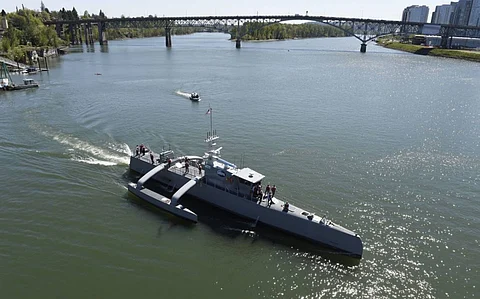

The deployment of unmanned surface vehicles (USV) by the world's navies continues to gain momentum. Thus far, though, the naval usage of USVs has been focused on the conduct of prolonged, repetitive coastal and littoral operations, such as long term patrolling and surveillance missions, and mine detection and clearance, using small USV platforms, such as the Israeli Protector, and UK's Autonomous Minesweeping System.
A recent announcement by US Navy Surface Warfare Director Rear Admiral Ronald Boxall signalled a likely future radical change to US Navy doctrine, namely the much greater use by the service of USVs in combat roles.
The US Navy's current top operational priority is to respond to the headlong advance of China's PLA Navy, which is probably adding some 20 to 30 warships to its fleet every year, although it has become difficult to make reliable estimates since 2018, when China clamped down on media reporting of the commissioning of new vessels.
The American deep-sea surface fleet is currently dominated by nuclear-powered aircraft carriers, and their main escorts, Arleigh Burke-class destroyers. These destroyers are highly effective units, bristling with powerful weaponry and sensors, but they are expensive, and absorb a great deal of scarce manpower.
The current thinking in the Pentagon is that USV technology is now sufficiently mature for it to be feasible to augment the manned fleet with a significant number of high endurance, relatively economical, USVs. A mix of small sensor-equipped craft, and much larger, weaponised, vessels is envisaged. Accordingly, a request for information on how best to achieve this goal has been put out to the defence industry.
It is very likely that a future USV programme will feature a development of the Defence Advanced Research Projects Agency (DARPA) Sea Hunter, a 40-metre, 145-tonne trimaran, built by Vigor Shipyards in Oregon, and dubbed an "anti-submarine warfare continuous trail unmanned surface vessel" (ACTUV).
The craft is powered by twin diesels, enabling a speed of 27 knots. Range is 10,000 nautical miles. Search and detection sonar is fitted, together with a full suite of radar, electro-optical detection, and electronic warfare equipment. Data link enables the ACTUV, which incorporates advanced autonomous navigation and anti-collision features, to be controlled from a remote operations centre.
Sea Hunter has been under test since 2016, and has reportedly been successful in the tracking of submarines. The US Navy has estimated Sea Hunter's daily operating cost at US$15,000-20,000, compared to about US$70,000 for an Arleigh Burke destroyer.
It is envisaged that large numbers of such craft, tasked with continuous dogging of PLA Navy surface and underwater activity, will be operated in conjunction with much larger combat USVs. The larger vessels will be equipped with a comprehensive range of missiles, and a large sensor suite, including 3D fixed array radar, enabling surface, air and sub-surface defence over a large areas, and will probably also operate unmanned aerial, and underwater, vehicles
It is intended that the small and large USVs will share many common components, and a common combat system…
The USVs will operate in conjunction with manned warships, with the former's high endurance providing a cost-effective way of sustaining US Navy presence in areas of operation.
The scene is set then, for the US Navy to be the first maritime force to field multiple combat-capable USVs in long range operations. Other navies are sure to follow suit.
